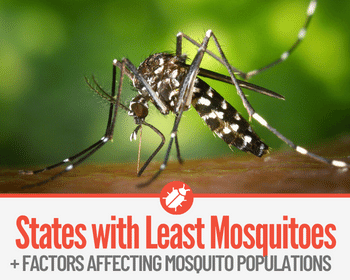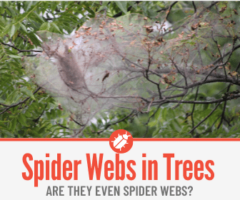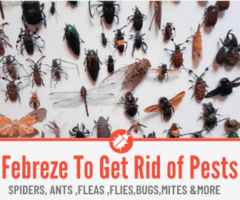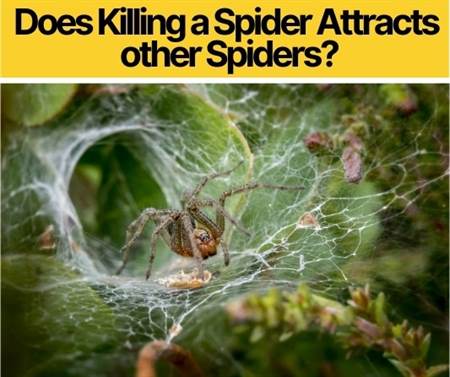 Everyone hates mosquitoes. These tiny bloodsuckers are anything from a nuisance—from the whine of a mosquito near your ear to the itchy red bump their bite leaves on your skin—to a disease-carrying menace.
Everyone hates mosquitoes. These tiny bloodsuckers are anything from a nuisance—from the whine of a mosquito near your ear to the itchy red bump their bite leaves on your skin—to a disease-carrying menace.
So, how many mosquitoes are there in the United States? And where can you go to get away from them?
Well, if you’re looking to move somewhere with no mosquitoes at all, the bad news is your options are limited to Antarctica or Iceland, as mosquitoes are in every state of USA.
The good news is, there are conditions that mosquitoes don’t do as well in. We’ll discuss those conditions and which parts of the USA meet them, below.
Hot and Arid Regions
Your best bet for moving to an area with fewer mosquitos is to head for the desert. While mosquitoes tolerate heat fairly well, extreme heat keeps their population down, and they don’t thrive well in dry conditions either.
The extreme heat and scarcity of water in desert regions of the USA, specifically southern California, much of Arizona and Nevada, and a small part of Utah, make these areas the best candidates for avoiding mosquitoes.
Mosquitos also need hosts from which to feed, and deserts have lower wildlife population density. This does mean that even within hot and dry states, bigger cities will still attract more mosquitoes.
This means that even in arid states, cities like Las Vegas, Nevada, and Phoenix, Sedona, Tucson, and Scottsdale in Arizona will still have higher populations of mosquitoes than the more sparsely populated parts of those states.
And although Southern California is arid, Northern California is less so, and you may find more mosquitoes there than further south.
Interestingly, up until a few hundred years ago Hawaii was mosquito-free, until fishing and whaling ships (and later tourism) brought outsiders to the islands, at which point the mosquitoes found their way to Hawaii, too.
Because of the heat and moisture in Hawaii, the mosquitoes thrived after their introduction to the islands. This means that no matter what the population of cities like Oahu, Kauai, Maui, or Kona may be, you will find mosquitoes.
Factors Affecting Mosquito Populations
Temperature
If the thermometer drops below 50 degrees Fahrenheit, mosquitoes can’t function. Extremely cold temperatures can kill some of the population.
At about 60 degrees, mosquitos can function but are less energetic and more lethargic.
Their ideal temperature range is 80 degrees or more.
Extreme heat can kill off much of their population (after an unfortunate initial population burst).
You might have noticed that the mosquito population increases and decreases with the weather and season.This is why it’s particularly hard to pinpoint states that will have the least mosquitoes as the size of the mosquito population isn’t constant.
Humidity
These pests love moist, humid conditions. Conversely, mosquitoes do not do as well in dry conditions. The drier a region is, the more difficulty mosquitoes face.
If the particular year in your state is dry, you will have fewer mosquitoes.
If you are looking to escape the mosquitoes while going on a trip – lookout for the past/current weather data!
Water
Related to their love of humidity, mosquitoes need water to breed. Saltwater or fresh, as long as it’s still water it is a habitat for mosquitos.
Running water does not work for their breeding purposes, though, so while ponds, lakes, swamps, salt marshes, etc, are big mosquito-attractors, running water and water with tides do not encourage mosquito breeding.
If you are close to a large body of water there will be more mosquitoes, if you are looking for an area in your state where the mosquito population will be the lowest this can be a very good indicator.
Food
Mosquitoes require hosts for the blood they feed on. Places with greater population density, both animal and human, will be more attractive to mosquitoes.
It’s worth knowing that the main Source of food for mosquitoes are different animals, not humans. Even if you live in an area with a small population density, if there is a lot of livestock around this will also affect the mosquito population.
Are Mosquito Bites Actually Dangerous in the USA?
Mosquito bites can be dangerous. It’s not the bite itself, but the diseases that the blood-consuming pest may carry.
Fortunately, the vast majority of mosquito bites in the USA will not cause you anything worse than some itching. Only a small percent of any given mosquito population in the US actually carries a disease, and only a small percent of disease-carrying mosquito bites actually result in infection.
Still, it is best to avoid mosquito bites whenever possible.
Avoiding Bites
So, it’s virtually impossible to travel or move to a place with no mosquitoes due to the changing mosquito population. Fortunately, it is possible to avoid being bitten by mosquitoes.
There are any number of products on the market to help you avoid a bug bite, from special clothing or wearable patches, candles or tiki torches that repel insects, bug zappers, spray.
Tricks like sitting in the airflow of a running fan might be able to give mosquitoes a harder time getting near you.
There are oils like lemongrass, peppermint, or eucalyptus that have reputations for repelling pests.
If you’re worried about mosquitoes on your own property, you can keep your yard well-mowed and keep an eye out for standing or stagnant water. If you have a birdfeeder or other water fixture, either change the water frequently or alter the fixture to keep the water in motion.
There are also mosquito control services that you can call, that will be local to your area.
Where Not to Go
The most highly mosquito-infested states in the US are likely to be in the South, particularly Florida, Georgia, Louisiana, Alabama, and parts of Texas.
These are places that stay relatively warm and wet all year long, ideal for mosquitoes to live and breed.
Where to Go
The places to go if you want a better chance of avoiding mosquitoes, again, are arid regions, like Southern California, most of Nevada and Arizona, and small parts of Utah.
Within that region, seek out low-population areas that are far from still water sources and are rather dry.






